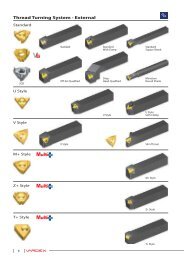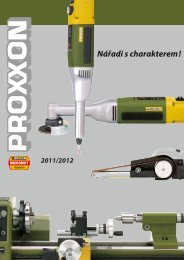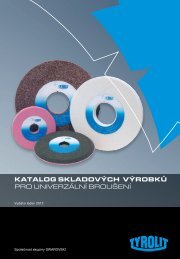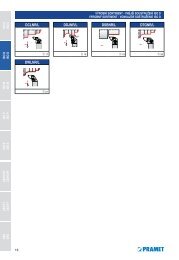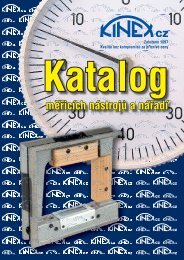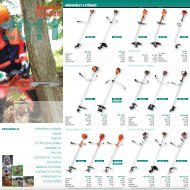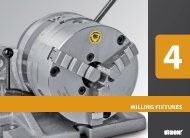Norton Industrial Catalog 7362 2011.indd
Norton Industrial Catalog 7362 2011.indd
Norton Industrial Catalog 7362 2011.indd
Create successful ePaper yourself
Turn your PDF publications into a flip-book with our unique Google optimized e-Paper software.
GENERAL INFORMATION<br />
Proper Grinding Wheel Operating Speeds and Safety!<br />
As abrasive wheel producers have known for many years, most grinding wheel breakages and injuries are caused by one major oversight. That<br />
oversight is operating a grinding wheel in an over-speed condition. A grinding wheel should never be operated at speeds greater than the wheel's<br />
rated speed.<br />
• Never use a grinding wheel with a rated speed less than that of the grinder<br />
• Never mount grinding wheels on sanders (Pistol Grip Air Sanders)<br />
• Never mount grinding wheels directly on electric motors<br />
• Never mount grinding wheels on the wrong size machine for the grinding wheel<br />
• Always properly maintain your machine: especially governors on pneumatic machines and linkage on floorstand machines<br />
• Never use the incorrect air, hydraulic or electric power supply<br />
• Never use the improper speed setting on a machine<br />
What you might not be cognizant of is that slight over-speed can cause damage to a wheel. If an operator continues to use this damaged wheel, it<br />
might break. In a reinforced wheel for example, cracks might form, be forced open and jam or catch the wheel on the workpiece resulting in a wheel<br />
breakage. The use of a 9" Type 27 Wheel on a 7" angle grinder is very dangerous! Normal stresses that occur during grinding along with the additional<br />
stress caused by over-speed are additive. The act of operating a wheel in a slight over-speed condition is very dangerous. We must understand and<br />
communicate this danger.<br />
One of the major forces at work on a grinding wheel is called<br />
“centrifugal force.” To demonstrate this force take a piece of string and<br />
tie a small weight to one end. Hold the other end of the string so the<br />
weight will travel in a circle. Rotate the weight and you will feel a pull on<br />
the string. The weight tries to fly off in a straight line, but the string<br />
holds it and compels it to travel in a circle. This pull on the string is<br />
called “centrifugal force.” Warning: If you attempt this experiment take<br />
all the proper precautions related to the object used to avoid injury to<br />
yourself or others.<br />
If you swing the weight at a speed of 50 revolutions per minute (RPM)<br />
and could measure the pull on the string at this speed, then increase<br />
the swing to 100 revolutions per minute and again measure the pull,<br />
you would find the pull was not merely two times greater, but was<br />
actually four times greater than it was at one half the speed. Therefore,<br />
the force increases exponentially with the speed or RPM.<br />
Centrifugal force increases in proportion to the square of the velocity.<br />
Think again of the weight and the string. We find that the square of 50<br />
is 2,500, (50 x 50 = 2,500); and the square of 100 is 10,000, (100 x<br />
100 = 10,000). As 10,000 is four times as great as 2,500, so is the pull<br />
on the string at 100 revolutions per minute four times as great as it was<br />
at 50 revolutions per minute.<br />
Centrifugal force applies to grinding wheels in the same manner as the<br />
weight to the string. Increasing the RPM or speed beyond the maximum<br />
safe operating speed (MOS) might be more dangerous than might be<br />
expected. Placing and operating a 9" Type 27 grinding wheel with a<br />
maximum operating speed of 6,600 RPM on a 5" right angle grinder<br />
with a rated speed of 10,000 RPM represents an over-speed of<br />
approximately 1.515 times the wheel's designated speed. The resulting<br />
rotational stress caused by the centrifugal force would be approximately<br />
2.3 times greater than the maximum allowed. Add this additional stress<br />
to the stresses that occur during normal grinding and even the<br />
strongest wheel might break.<br />
In short, NEVER over-speed a grinding wheel. Always compare the<br />
speed marked on the wheel or package to make sure the machine’s<br />
speed is at, or below, the speed or MOS of the grinding wheel. Speed<br />
can kill. NEVER over-speed a grinding wheel.<br />
304 NORTON – THE MUSCLE BEHIND THE MACHINE





